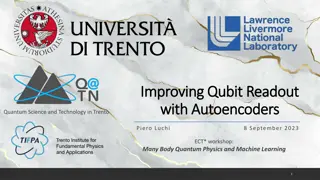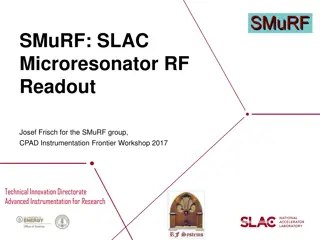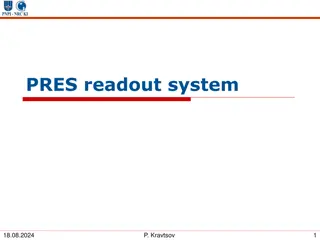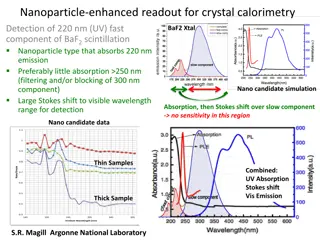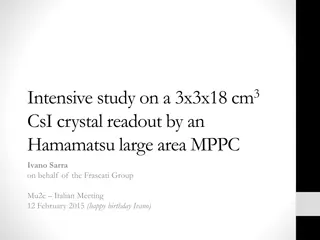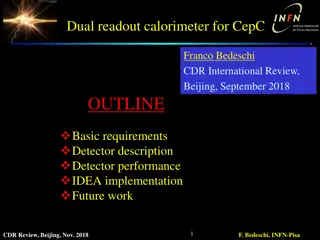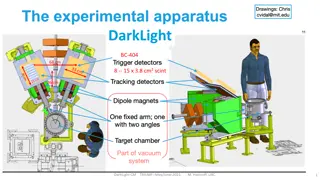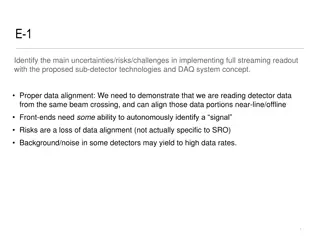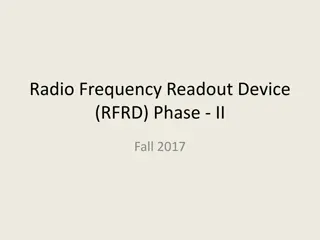Simulazione Applicazione della Tecnica del Dual Readout
This content discusses the application of the dual readout technique in simulation, authored by M. Bongi and S. Bottai on 12/11/2015. Explore the concepts and methodologies involved in this simulation technique and its relevance in various fields.
Download Presentation

Please find below an Image/Link to download the presentation.
The content on the website is provided AS IS for your information and personal use only. It may not be sold, licensed, or shared on other websites without obtaining consent from the author.If you encounter any issues during the download, it is possible that the publisher has removed the file from their server.
You are allowed to download the files provided on this website for personal or commercial use, subject to the condition that they are used lawfully. All files are the property of their respective owners.
The content on the website is provided AS IS for your information and personal use only. It may not be sold, licensed, or shared on other websites without obtaining consent from the author.
E N D
Presentation Transcript
Simulazione:applicazione della tecnica del dual readout M. Bongi, S. Bottai , 12/11/2015
THE SIMULATION & RECONSTRUCTION TOOL Fluka-based MC simulation 3,6cm CsI Scintillating crystals Scintillation Light collection efficiency and PD quantum efficiency (BGO , PWO ..) Photodiode Energy deposits in the photodiodes due to ionization are taken into account Carbon fiber support structure (filling the gaps between crystals) Number of crystals passed via parameter New dedicated versions for Cherenkov and Neutrons detection added recently (to be finalized and eventually unificated with standard version) C++ reconstruction tools Noise Shower axis reconstructed by fit No MC truth is needed in the analysys Lateral and longitudinal profiles respect to axis Point of first interaction along axis Length from first interaction to end of calorimeter ............................................................................ -
DUAL READOUT IN CALOCUBE APPLY THE C/S CORRECTION TO CALOCUBE Vertical protons E=100 GeV, interacting in the first layer Scorrected/E S/E RMS=20% RMS=22% C/S C/S C=cherenkov and S=scintillation signals properly normalized RESOLUTION IMPROVEMENT ~ 10% 3
ACCESS CALORIMETER : THIN SAMPLING CALO Vladimir Nagaslaev, Alan Sill, Richard Wigmans TEST BEAM ANALYSIS ~ 10% IMPROVEMENT DUE TO DUAL REDOUT ~ 10% 4
E=Ee +Eh Ee=E*fem Eh=E*(1-fem) Sem =Ee * ke Energy lost in ionization by electromagnetic fraction Shad=Eh * kh Energy lost in ionization by hadronic fraction E calorimeter EE EE Sem =Ee * ke Typical values in our calo ke~ 0,95 Shad=Eh * kh Eh Eh kh~ 0,1-0,2 Nucl excit., neutrons, p leak. ! +/- 5
With Scintillation only we see total contribution to energy loss Erec= Stot= (Sem+Shad)= (Ee * ke+ Eh * kh)= (fem * E * ke+ (1-fem)*E * kh) If ke khthe fluctuation of fem induce a fluctuation on Erec If ke= kh Erec= (fem * E * ke+ (1-fem)*E * kh)= ke the fluctuation of fem DOES NOT induce a fluctuation on Erec BUT ALSO FLUCTUATIONS ON kh PLAY THE GAME 6
2,8 ICSI calo 10 TeV =20 % Electromagnetic fraction (fem) 2,8 ICSI calo 10 TeV =38% Kh=Had Energy dep/Had Energy
With Scintillation only we see total contribution to energy loss Erec= S= (Sem+Shad)= (Ee * ke+ Eh * kh)= (fem * E * ke+ (1-fem)*E * kh) Scintillation + Cherenkov (or neutrons) give information separately on Semand Shad(not on Eh) THE 'IDEAL' DUAL READOUT ALLOWS TO PERFECTLY MEASURE Semand Shad Sem Shad < ? > ??? ? ?? < ??> 1 ??? ? ?? < ? > Erec = < ??>+ = + propagating errors with approx of gaussian independent distributions Typical values in our calo ke~ 0,95 kh~ 0,1-0,2 Once we know Shad, to reconstruct Eh, E, fem we need to use the constant 1/<kh> which can be large and hence increase the fluctuations of kh term 8
STUDY OF CHERENKOV CORRECTIONS METHODS VERSUS CALO DEPTH NEW SIMULATION x 3 WE SELECT 8 DIFFERENT SET OF VERTICAL SHOWERS FAR FROM BORDERS. IN EACH SET THE SHOWERS HAS FIRST INTERACTION IN THE SAME CSI LAYERS IN EACH SET THE SHOWERS SEE THE SAME CALO LENGTH FROM FIRST INT. TO END THE 8 SETS CORRESPONDS TO 8 DIFFERENT CALO DEPTH FROM 5,6 ITO 1.6 I 9
4 methods of energy reconstructions compared Erec= S (all showers see the same calo length, no length correction needed) SCINTILLATION ALONE (S/E) Use Cherenkov/S to correct S ????= ? ????? ? ? (A. Para) C/S Cherenkov correction DREAM like S=E [ fem+(1-fem) (<kh>/<ke>) ] C=E [ fem+(1-fem) (<kh>/<ke>)c] R=[1 - (<kh>/<ke>)c] / [1 - (<kh>/<ke>) ] ?? ? ? 1 ????= Ideal dual detector , Seand Shtaken separetely event by event from simulation truth ?? < ??>+ < ? > ? ???? = ? 10
RESULTS 10 TeV protons 1,9 Scintillation alone (Erec-E)/E (%) Cherenkov corr. C/S 3 Chrenkov corr. Dream Ideal dual detector standard Calocube 20x20 1,9 5,7 CSI Calo length from 10interaction to end (cm) The resolution gain is roughly equivalent to add ~3 CSI plane 11
Resolution with Cherenkov corrections (gaussian fit to peaks) Relative Resolution Gain (Erec-E)/E (%) 10 TeV protons 1,9 1,9 3 Relative Resolution Gain Scintillation alone 5,7 Cherenkov corr. C/S 3 5,7 standard Calocube 20x20 1,9 Cherenkov corr. C/S 10 TeV protons CSI Calo length from 10interaction to end (cm) CSI Calo length from 10interaction to end (cm) Relative Resolution Gain (Erec-E)/E (%) 10 TeV protons 1,9 Scintillation alone 5,7 1,9 Relative Resolution Gain 3 Cherenkov corr. C/S 3 Chrenkov corr. Dream Ideal dual detector standard Calocube 20x20 1,9 5,7 Ideal dual detector CSI Calo length from 10interaction to end (cm) CSI Calo length from 10interaction to end (cm) 12
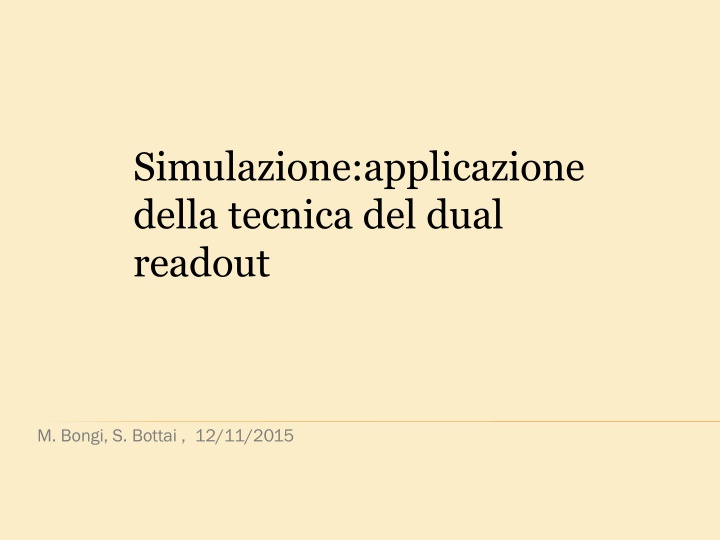

![Read ebook [PDF] Infiammazione Zero La Promessa Della Dieta Antinfiammatoria](/thumb/9900/read-ebook-pdf-infiammazione-zero-la-promessa-della-dieta-antinfiammatoria.jpg)

